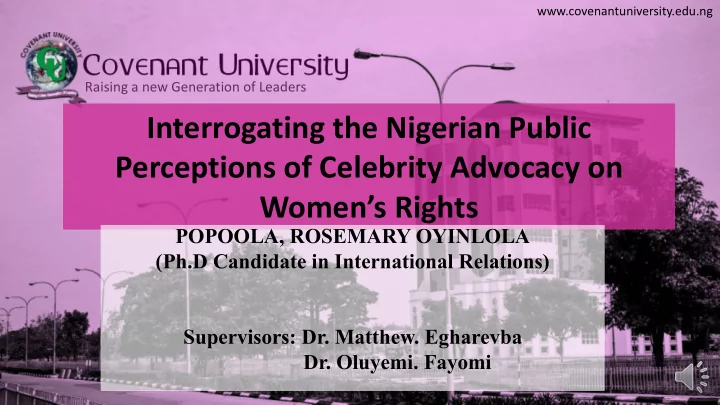

www.covenantuniversity.edu.ng Raising a new Generation of Leaders Interrogating the Nigerian Public Perceptions of Celebrity Advocacy on Women’s Rights POPOOLA, ROSEMARY OYINLOLA (Ph.D Candidate in International Relations) Supervisors: Dr. Matthew. Egharevba Dr. Oluyemi. Fayomi
Introduction • Celebrity advocacy is gaining prominence • Lack of research in that area • The study fills this gap 2 www.covenantuniversity.edu.ng
Nigerian Celebrity Advocate
Nigerian Celebrity who speak out on personal experience with Abuse
Advocacy 5 www.covenantuniversity.edu.ng
RESEARCH METHODS Research design • The study employ survey research design. Particularly, the cross-sectional survey design was employed because the study is descriptive, exploratory and explanatory in nature Population of the study • The population of this study comprises four distinct groups namely: women’s rights activists, women’s rights organizations, and residents of the two selected states. 6 www.covenantuniversity.edu.ng
Research methods cont.D Sampling Technique • The study employed multi-stage sampling technique and complemented it with probability (particularly cluster sampling) and non-probability sampling (purposive sampling technique). Sample size • The sample size of 384 was for each of the state and summing it gives sample size of 768. This was arrived at using Krejcie and Morgan (1970) sample size determination table. A sample size of 768 was drawn from a population of 12, 741, 722 that constitute the study population. 7 www.covenantuniversity.edu.ng
Research Methods Cont’D • According to Krejcie and Morgan (1970) for a population which is equal to or greater than 1,000,000, the required sample size is 384. In order to determine the proportional sample size: SP = NXS TP • Where SP is the sample population, N is population size of the RNS, s is sample size and TP is the total population. 8 www.covenantuniversity.edu.ng
Research Methods Cont’D S/N Organization Lagos & Ogun 1. Non-Governmental Organizations(NGOs) with focus on 6 Women’s rights 2. Women’s rights activist /experts 8 3. General Population 384 x 2=768 4. 782 Total 9 www.covenantuniversity.edu.ng
Research Methods Cont’D Method of Data Collection • The study engage mixed methods of data collection. Primary data was sourced using questionnaire and qualitative data sourced from in-depth interview and focused group discussion. • Instruments of Data Collection Data was sourced using a questionnaire; in-depth interview and Focus Group Discussion was conducted with voice recorder in consonance with the respondents’ approval. 10 www.covenantuniversity.edu.ng
Research Methods Cont’D Validity of instrument of Data Collection • The content validity was adopted for this study to validate the instruments used, subjecting it to four independent assessors including the main research supervisor and three other researcher with vast experience in gender and advocacy studies. Reliability of Instrument of Data Collection • A test –re-test reliability was engaged as the same measuring instrument was used to take two separate measurement on the same population at different times. Complemented by confirmatory factor analysis approach. 11 www.covenantuniversity.edu.ng
Research Methods Cont’D Technique for Data Analyses Logistic regression, cross tabulation, chi-square were used to analyze the data with the use of Statistical Package for Social Sciences (SPSS) version 21 and SAS . Qualitative data gathered from interviews and Focus Group discussions, were transcribed and subjected to thematic analysis and narrative techniques was employed where necessary. 12 www.covenantuniversity.edu.ng
Demographic representation Gender distribution of respondents Age of respondents 51 years and above; 51; 8% Male ; 174; 28% 18-28 years; 125; 20% 40-50 years; 239; 39% Female; 440; 72% 29-39 years; 199; 33% Gender Male Female Age 18-28 years 29-39 years 40-50 years 51 years and above
Demographic representation Cont’D Working status Educational qualification 500 450 450 400 459 416 400 350 350 300 300 working status 250 250 200 200 150 150 100 102 100 77 50 83 50 60 1 18 0 12 0 Employed not employed Housewife self-employed employer Education SSCE B.Sc. and its Postgraduate Other professional Titolo asse equivalent qualification
Residence of Respondents Respondent's residence Ogun State; 209; 34% Lagos State; 405; 66% Residence Lagos State Ogun State 15 www.covenantuniversity.edu.ng
Celebrity Advocacy and Women’s right promotion Celebrity collaboration with NGO’s Celebrity partnership with NGO’s 4; 2% Strongly disagree; 15; 3% 43; 18% Strongly agree; 90; 16% Disagree; 89; 16% Undecided; 57; 10% 119; 49% 40; 16% Agree; 304; 55% 36; 15% Strongly disagree Disagree Undecided Agree Strongly agree Strongly disagree Disagree Undecided Agree Strongly agree
Celebrity Advocacy and Women’s right promotion • Authenticity Celebrity image and women’s right advocacy 400 • Degree of Involvement 350 342 “Cause” Misappropriation • 300 250 200 150 100 101 68 50 44 16 0 Strongly disagree Disagree Undecided Agree Strongly agree
Themes from Interview and FDG • Accountability /Authenticity • NGO regulation Bill, Celebrities and NGO as agent of western cultural imperialism • Indigenous vs Alien nature of women’s rights advocacy • Financial Implication of Celebrity Advocacy 18 www.covenantuniversity.edu.ng
Themes from Interview and FDG • Effectiveness • Public Perception of the Celebrity advocate • Impact on NGOs that engage them 19 www.covenantuniversity.edu.ng
Summary/Conclusion • The result revealed that celebrity advocacy when creatively engaged can be useful in the promotion of women’s rights but not necessarily in its protection. As reveal in the empirical evidence based on distributed questionnaire and qualitative interpretation through thematic analysis of interview and focus group discussion, key informants acknowledged that celebrity advocacy tool is useful and effective in its own way for highlighting incidence of women’s rights violation and promoting women’s rights but more still needed to be done beyond highlighting these issues, including putting the right mechanism in place to enforce/ protect these rights. 20 www.covenantuniversity.edu.ng
Thank You 21 www.covenantuniversity.edu.ng
Recommend
More recommend